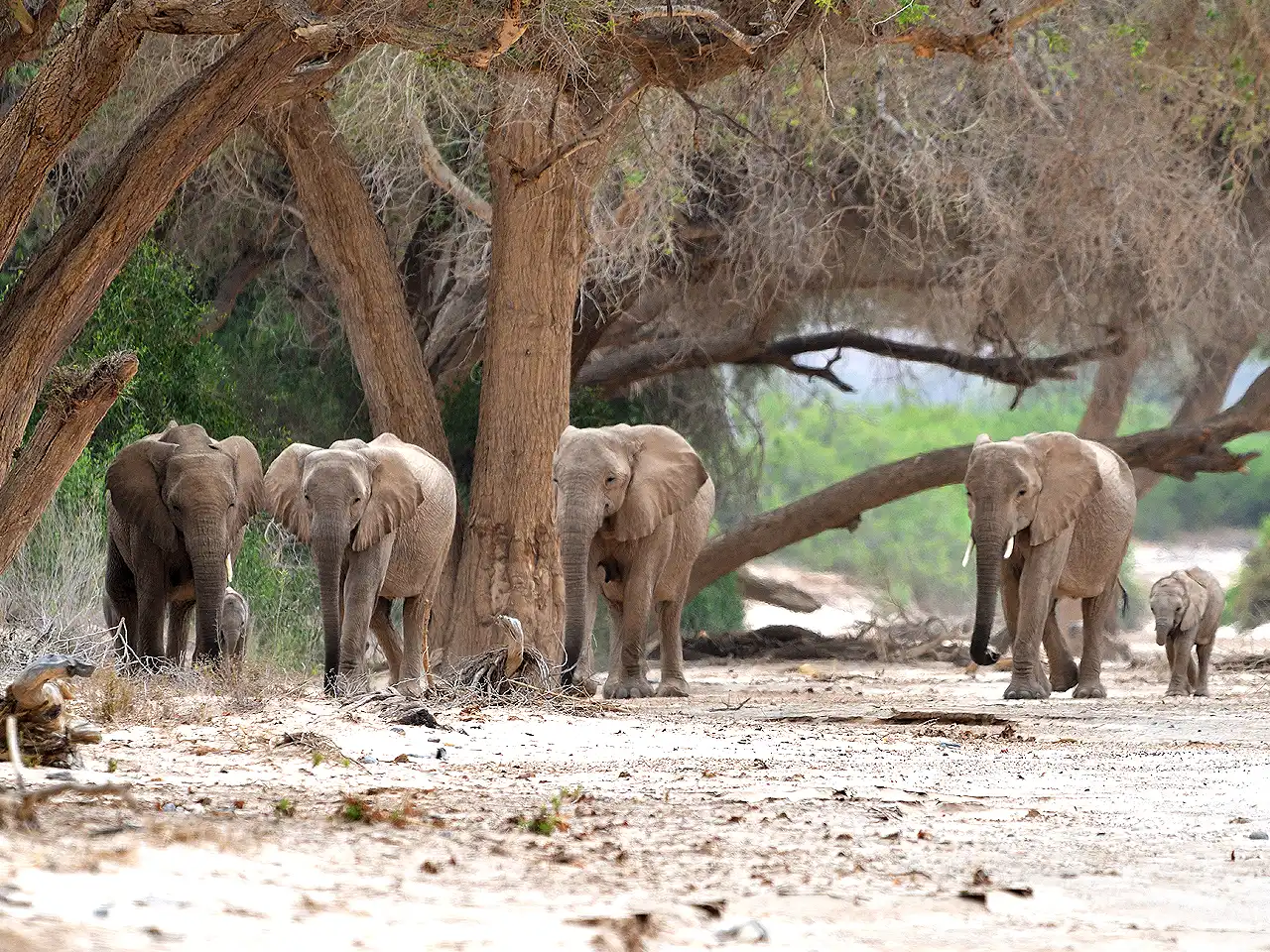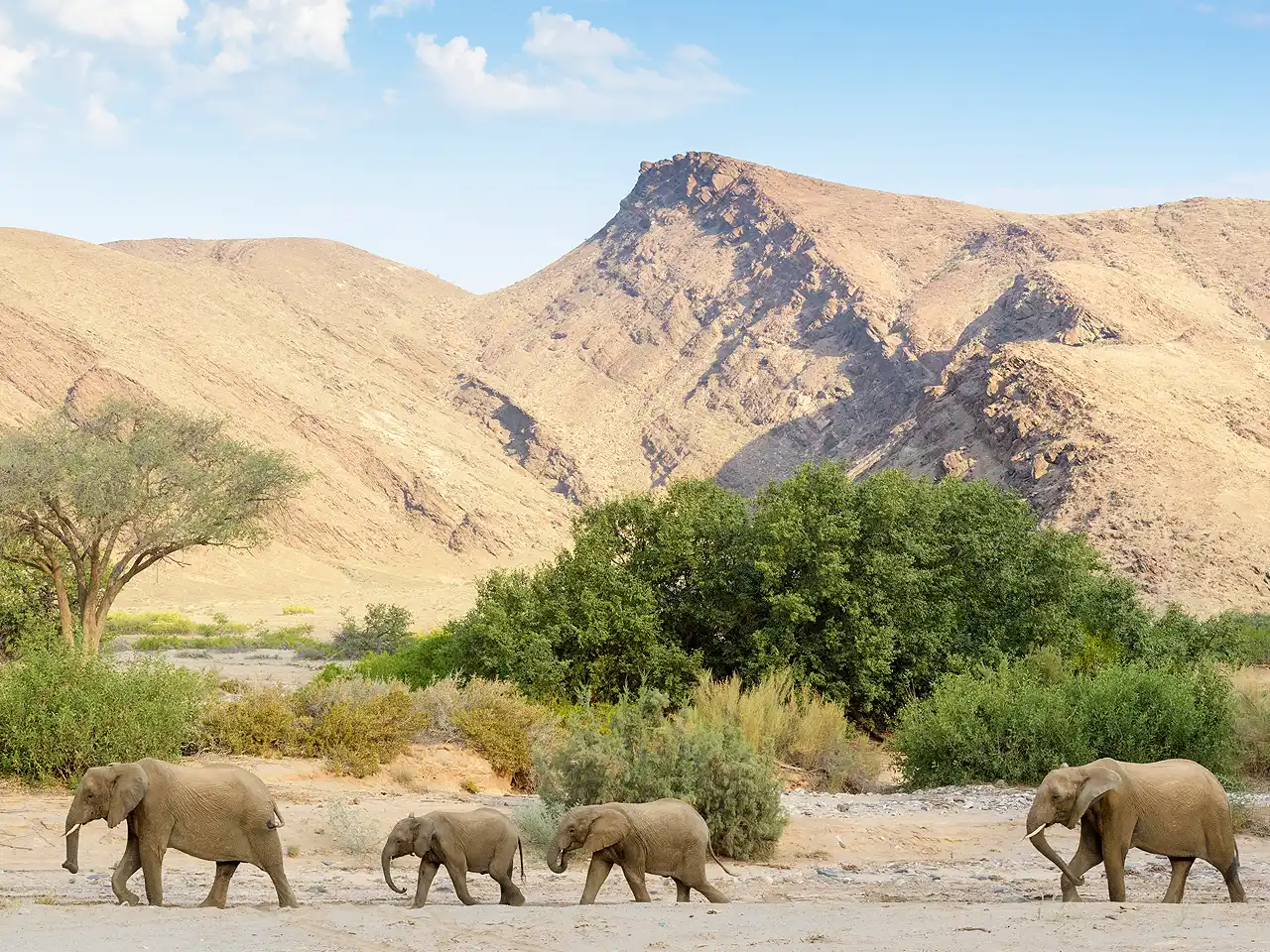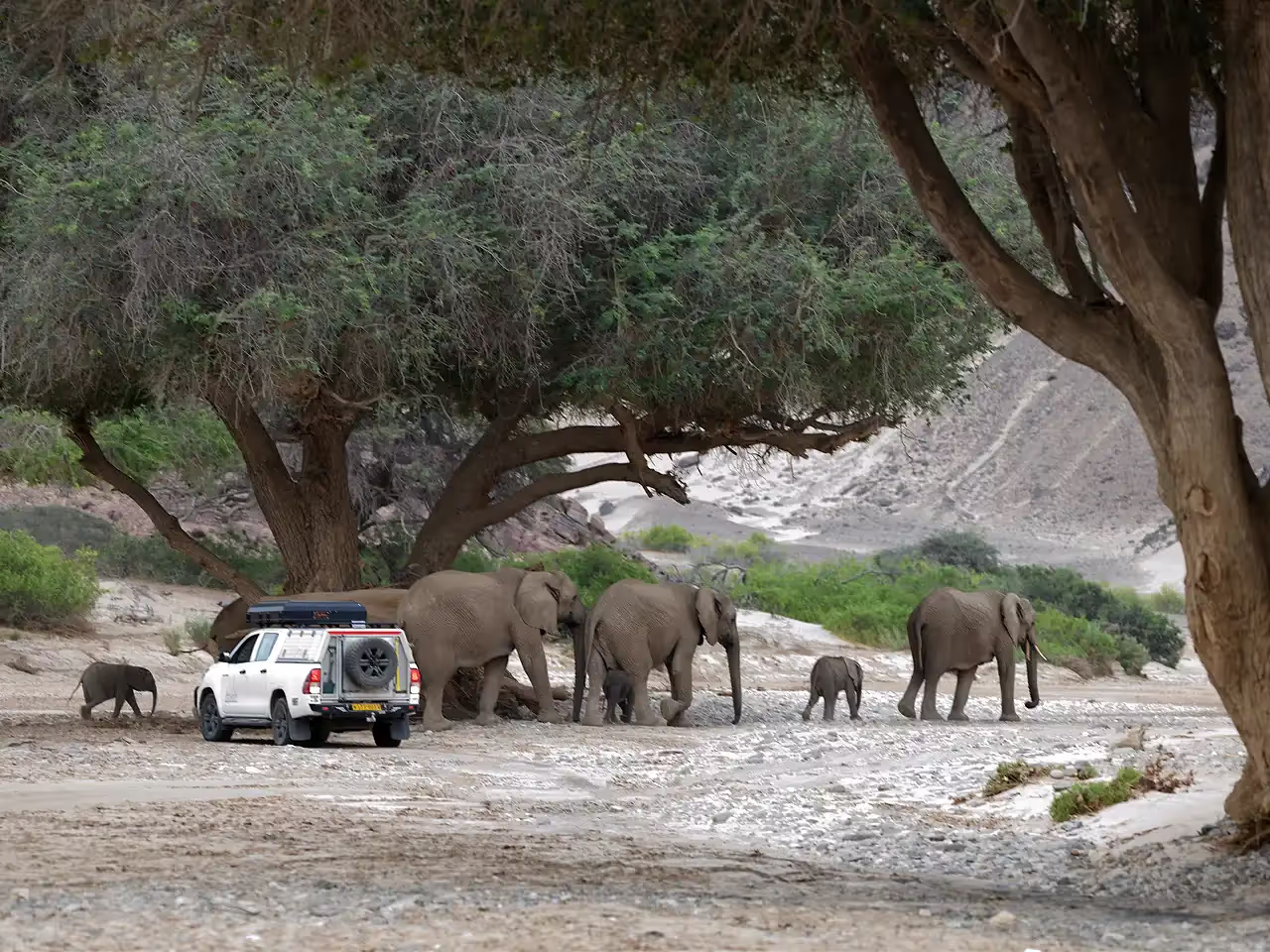



If you happen to find yourself wandering through a desert, you’re likely to be as surprised to see a herd of wild elephant as you would a gushing waterfall. But elephants living in the desert used to be a fairly common sight across Africa. These days, their populations are limited to areas of Mali and the northern reaches of Namibia’s Namib Desert.
Spotting them in the wild is certainly as bucket list worthy as ticking off the rest of the Big 5. So how can you ensure your trip to Namibia gives you the best chance of seeing these magnificent mammals trudging across the sand?
The answer is to read this guide we’ve compiled. It starts with an overview of the habitat and habits of desert-adapted elephants, and then focuses on where you’ve the best chance of seeing them and how to increase your chances of getting eyes-on.

There have been debates as to whether desert adapted elephant should be considered a separate species from the more prevalent African savannah elephant. Many have concluded that, no, it’s not a separate species, simply an elephant that’s adapted to allow it to survive and thrive in the barren landscapes they call home. So now you know.

It’s a wonder anything manages to survive in areas with high heat and low rainfall, let alone mammals as large as elephants.
Their nomadic lifestyle sees them travel miles and miles across arid landscapes looking for food and water, relying on seasonal rivers for their supplies of the wet stuff. And the ways this elephant has adapted helps them thrive in these seemingly harsh and unfriendly conditions.
Deserts are not known for their plentiful water supplies, and the elephants that live here have adapted accordingly. Females and young elephant can limit their drinking to once every three days, while the males can go five without water. Compare this to the voracious appetite most African elephants have for drinking, putting away as much as 200 litres of water every day.
The longer trunks and legs of desert adapted elephant make for handy tunnelling tools to dig down into dry riverbeds to find any water supplies below the surface. And experience tells elephants where the best sources of seasonal water and man-made rivers are located.
Elephant are known for totally destroying the plants and trees they eat, ensuring there’s nothing left for anyone else to enjoy. That’s not the case with Namib Desert Adapted elephants who’ll take their share from the plant but leave enough behind for it to grow again so they can return for another feed sometime in the future. The elephant has adapted to survive on a low quantity, low nutrient diet which has led to their tusks being more brittle than their African cousins’.
Whisper it quietly, but desert elephants have big feet. Bigger than the big feet you’d expect any kind of elephant to have. No one likes attention being drawn to this kind of thing, of course, but in the case of these elephants, there’s no escaping it.
Some say their feet merely appear bigger because their bodies are smaller and legs longer. But, if they were being measured for shoes (or more likely sandals), there’s little doubt that desert elephant feet would fall into the XXXL bracket.
That’s the way their feet have developed over years of traversing miles and miles of desert looking for food and water. A larger footpad size makes it easy to travel across sandy plains and sandy dunes without sinking in.
They say only fools and Englishmen go out in the midday sun. And these elephants are no fools, or indeed Englishmen. They travel by night on their quest for food and water in smaller herds than other kinds of elephant – which means smaller food and water sources are required.

When visiting Namibia, you’re likely to land in the capital, Windhoek’s main international airport. From there, you’ll need to head northwest into the Kunene region, through Damaraland toward the Skeleton Coast in the Namib Desert.
In the shadow of the Brandberg Mountain, Namibia’s highest, is prime desert elephant country. The Ugab River, which only appears above ground for a few days per year, is their kind of territory, with enough water and vegetation to attract the elephant. The Aba Huab River – whose bed is also dry for most of the year - is another area ripe for sightings.
Destinations that provide good places to base yourselves for sightings of the elephant include:
Madisa Camp & Campsite
Brandberg White Lady lodge
Palmwag
Khowarib Lodge
Camp Kipwe
Mowani Mountain Lodge
Twyfelfontein Adventure Camp

Given their wandering habits and the vast distances they cover, desert adapted elephants can take some finding. Unfortunately, they don’t tend to follow man-made roads, so you’ll likely need to veer off the beaten track to have the best chance of seeing them.
Some elephant have humane GPS tracking devices attached to them which enables conservationists to record their movements, giving those with access to the information vital data on their habits and behavioural patterns. This can certainly help with predicting where herds are likely to be at any given time.
If/when you do find a herd, the experience is all the more rewarding given the time you are likely to have spent on your search – although you may get lucky and not spend long at all searching.
However long they take to track down, care should be taken whenever in the vicinity of wild animals, even herbivores. These elephant aren’t always the gentle giants we’d like to think they are. Poaching, together with conflicts between herds and local human populations for the scant vegetation that grows in the area have seen elephant numbers reduce from over 3000 in the early 1900s to the 150 or so that survive today.
As with most safaris, you’ve the best chance of seeing the wildlife you want to see when you book a place on a tour led by an experienced ranger or tracker who knows the local area.
It’s very rare to find desert elephant without expert guidance. But if you’re determined to go it alone, who knows, you could get lucky!

Our Classic Namibia Safari spends several days in Damaraland, including some of its most remote areas, prime sighting ground for these elephant. We offer a private guided experience that takes in many areas of central and northern Namibia.
We also offer a self-drive Namibia Highlights Safari which again takes you through Damaraland. It’s the same with our Namibia Highlights Fly-in and Guided Combo. We can also arrange bespoke itineraries for you to help increase your chances of seeing these magnificent mammals.




"A dream come true"
We had the most amazing family holiday, everything worked so perfectly, the arrangements and accommodation was spectacular!
"Unforgettable trip to Namibia – Thank you Namibia Tours & Safaris!"
We are a group of four from Romania and spent 3 unforgettable weeks in Namibia. We can't recommend them enough, and for any future travels in Namibia or other parts of Africa, we will definitely use their services again.
"We had a great experience"
From the time we put the key in the ignition till we boarded the plane in Windhoek nothing went wrong.
"Unforgettable bird photography trip in Namibia"
It was a fantastic experience, everything was very well organised, went smooth and according to expectations. It was our first self drive in Africa and it was a great, unforgettable time.